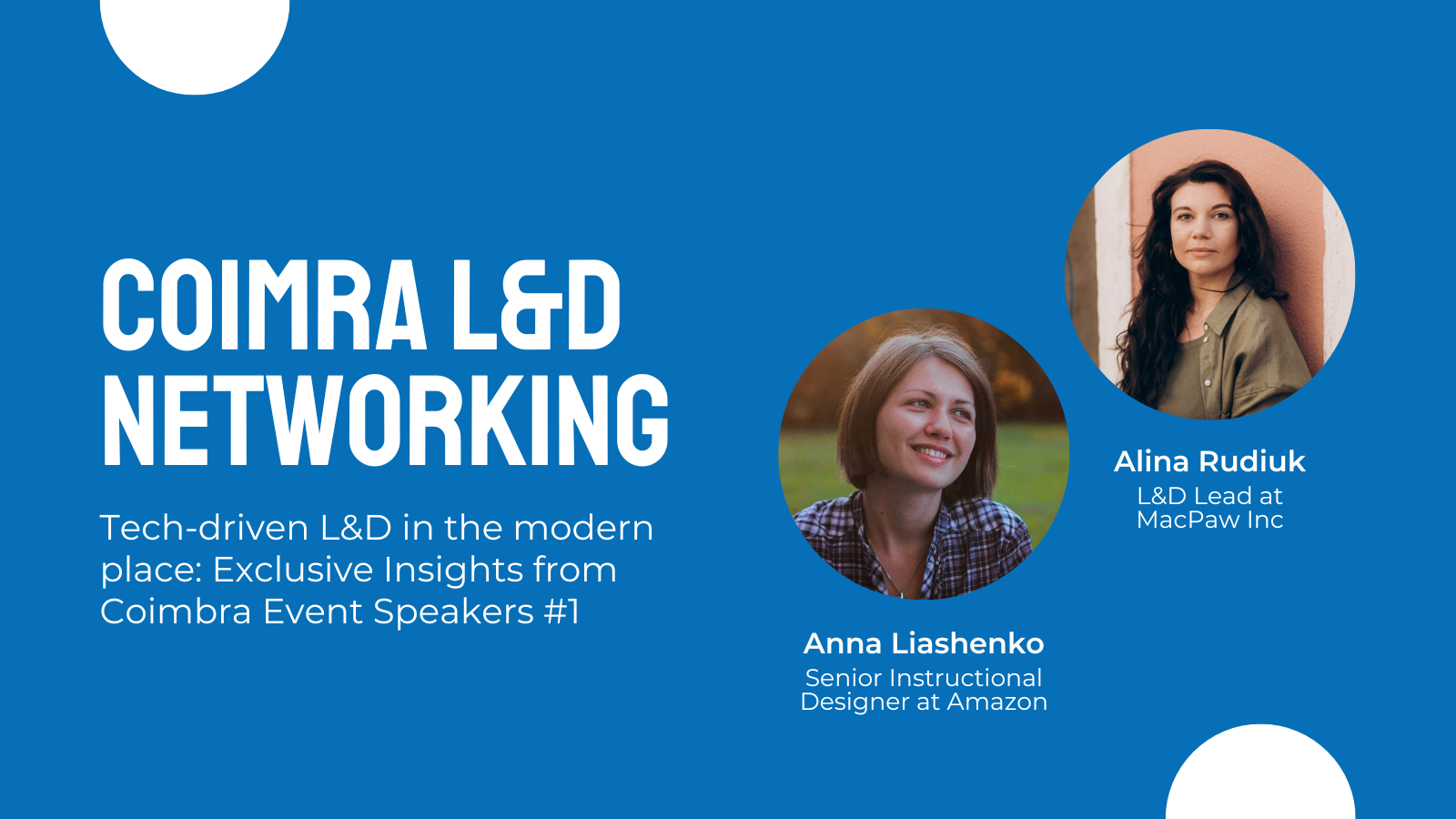Unlocking Learning and Development Insights

The Coimbra L&D Networking event, a gathering of experts and thought leaders in the field of Learning and Development, provided a platform for insightful discussions on key aspects of designing effective learning processes. Attendees had the privilege of asking our speakers, Alina Rudiuk and Anna Liashenko, questions directly, yet we did not have time to answer all of them. That is why we decided to share the answers in an article.
You'll find the other half of the questions and answers in a second article soon!
What are the key points to consider when designing a learning process?
Anna:
This question is worth a PhD degree 😊. For me, when designing a learning process, it's important to stick to a learner-centered approach. This means focusing on the needs, gaps, motivations, and learning preferences of the learners. Not on the topic (even if it's really interesting) or the experts. Here are the key points to consider:
1. Conduct Learner and Stakeholder Needs Analysis:
- Invest time in understanding the learning needs, knowledge gaps, and motivations of the learners.
- Conduct a thorough stakeholder analysis to comprehend the varying interests and expectations, ensuring alignment with organizational objectives and learner needs.
- Establish measurable goals and clearly define what success looks like to determine the impact and effectiveness of the learning intervention. If a goal isn’t measurable, refine it until it is.
2. Align Training with Learner Needs:
- Ensure every component of the training is designed to address the identified needs and gaps of the learners.
- Rigorously question and evaluate the necessity of each content piece; if something doesn’t serve to fill the identified gaps or needs, reconsider its inclusion.
3. Manage Cognitive Load:
- Be mindful of the cognitive load, striving to achieve more with less to facilitate optimal learning.
- While content is essential, it’s not everything. Focus on facilitating understanding and application, utilizing various instructional strategies and media.
- Use scaffolding: structure the learning materials and activities in a coherent, logical sequence, ensuring complexity increases gradually.
- Include practice and reflection. Provide ample opportunities for practice and feedback to reinforce learning and address misconceptions.
4. Incorporate Motivational Design:
- Address learner motivations through engaging and relevant content, activities, and incentives. Consider using a motivational design model, like Keller’s ARCS.
- Design learning experiences that are intrinsically rewarding and aligned with learners’ values, interests, and career goals.
5. Accessibility and DEI:
- Ensure the learning materials and activities are accessible to all learners, considering diverse needs, preferences, and learning contexts.
Final Reflection: a thorough analysis and evaluation strategy upfront are key for the learning design process. If these are not done properly, the whole project is at risk.
Have you faced difficulties getting remote workers to use the LMS or with them taking a long time to complete modules? If so, how did you overcome it?
Anna:
I’ve encountered difficulties with getting teams (all teams, not only remote) to use LMS before. There’s no single recipe to fix this, but the first question you should ask is: do they really need an LMS? And what’s in it for them — why would they choose to spend time on LMS instead of hanging out in Slack or getting urgent tasks done or just enjoying a nice cup of coffee? If you can answer this question, then I’d look into the following issues first:
1. Lack of Integration:
Employees usually spend time on email, Slack, and Zoom. LMSs, being standalone systems, aren’t in the daily digital pathway of users. Solution: Integrate LMSs into the platforms your employees are using. Or, at least, integrate learning reminders and prompts into daily-use platforms. For example, consider using an LMS, which has a Slack chatbot to notify and remind employees about learning tasks.
2. Absence of Community Engagement:
People learn from people (quite often). So, your LMS should accommodate not only self-directed learning or direct instruction (trainer to learners) but also more informal kinds of social learning — discussions, roadshows, skills exchanges, conferences, etc. If your LMS isn’t promoting or linked to community interactions, it’s missing a crucial motivating factor.
Solution:
- Link the LMS to active communities or discussion forums — even if it’s one channel on Slack.
- Make sure it’s ‘cool’ to learn on your LMS. Encourage management and peers to share what they’re learning on your LMS and how happy they are about it.
3. User-Unfriendliness:
If an LMS is hard to navigate, it’s a barrier. Opt for user-friendly LMS interfaces, and if that’s not possible, provide clear, easy-to-follow training on using the LMS.
How to interact when the team is located in different parts of the world, time zones, and in different cultural contexts?
Alina:
I don't think there is a magic pill that can help easily interact and engage teams in a multinational and multicultural environment. But here are 5 main points to consider from my point of view:
1. Establish clear communication rules:
- create clear and accessible communication channels and expectations for response times. Make sure everybody is aware of “how we communicate” recommendations.
- consider scheduling regular team/company meetings to keep everyone updated on project progress concerns and foster a sense of unity using asynchronous tools.
2. Respect Time Zones:
- be mindful of scheduling meetings. Schedule meetings during the times everyone can attend. If there is no such option, develop a culture of asynchronous meeting attendance & feedback/questions providing (using meeting recordings & app like Slido or others).
- if possible, rotate meeting times to accommodate different time zones so that no one consistently bears the burden of attending meetings at odd hours.
3. Use inclusive language:
- opt for inclusive language that avoids idioms, slang, expressions, or humor that may not be universally understood.
- encourage colleagues to ask for explanations if something is unclear due to cultural or language differences.
- use technologies to add different languages to company meetings - synchronic translators and AI translators.
4. Be aware of cultural sensitivity:
- learn about cultural differences, norms, and values of your team members. Be ready that differences can impact communication styles, decision-making processes, etc
- try to avoid biases, assumptions, or stereotypes about team members based on their cultural backgrounds. Encourage open dialogue to bridge cultural gaps and promote understanding. Be a cultural difference ambassador.
5. Build a strong team culture:
- foster a sense of community and belonging within the team by celebrating diversity. Be an ally of each other.
- consider organizing virtual team-building activities or cultural exchange events to strengthen bonds and build trust among team members.
By following these guidelines, you can create an environment that promotes effective collaboration and minimizes the challenges associated with having a globally dispersed and culturally diverse team.
As the Coimbra L&D Networking event sparked valuable insights and discussions, we invite you to join us for our second Coimbra event on November 24th. Don't miss the opportunity to engage with industry experts, gain further insights, and enjoy networking and great food and drinks!
Register now to be a part of this enriching experience: https://lu.ma/coimbrald2


